#oliver darlington
Text

Oliver & Florence Darlington
Although Oliver and Florence each got their own memorandum posts, they as the founders of this legacy deserve their own as well. They took us through almost thirty years together, out of the Victorian Era and into the Modern Age.
They were the first, and perhaps the most exemplary love story that this legacy will ever have. Together they sought a somewhat simple notion of freedom, tied to the natural world and a pastoral life. This desire brought them to Henford-on-Bagley, where they achieved the life that they had always dreamed of and raised four unique, independent children to carry on their legacy into the 20th century. With both of their passings, the legacy has truly entered a new era, less tethered to its roots at Darlington Manor in England than ever before.
Sentimental photos of these two being positively wholesome and in love throughout their decades together below the cut.

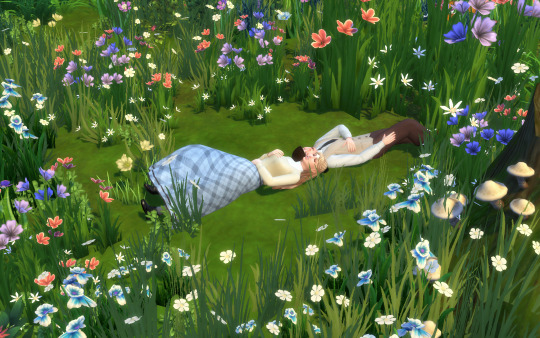










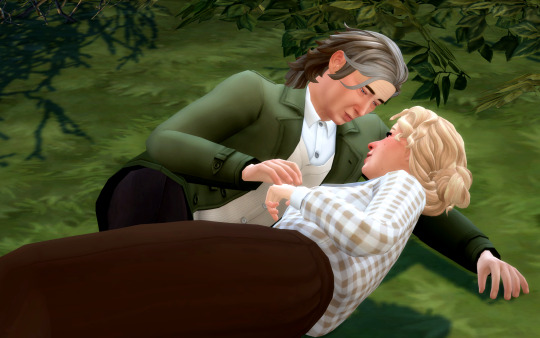
#I am absolutely positively not crying#now it truly feels like the end of an era and all my gen 2 baby darlington siblings are truly scattered to the winds of history#sims 4 historical#ts4 historical#ts4 decades challenge#sims 4 decades challenge#sims 4 legacy#ts4 legacy#sims 4 story#ts4 story#the darlingtons#1920s#florence darlington#oliver darlington
93 notes
·
View notes
Text
Ophelia how did you get a fucking Door-
Note: the blonde girl at the beginning belongs to a friend who doesn't have Tumblr, they let me use her for the story!
#my art#artists on tumblr#original characters#silly#funny#art#Valentina Darlington#Nyla Tealin#Knave Cardian#Dice Spadia#Oliver Mistin#Ophelia Pips#Eadwig Fullim#Jackio Lune
6 notes
·
View notes
Text

Anthony Fineran (B 1981), Wycombe Darlington Olive Reid, 2022
0 notes
Text
Doesn’t everything die at last, and too soon? Tell me, what is it you plan to do with your one wild and precious life?
Mary Oliver

Wish upon a paper butterfly
by Kerry Darlington
23 notes
·
View notes
Text
What is the 'Engine Rulebook' and where did it come from?:
So, this really early era of railways was a bit insane, and I am not quite well-versed enough to make a case-study out of everything - but like with my Big 4 scrap post, this is more about trends than singular examples - though some do appear.
The 'Engine Rulebook' is basically the set of rules that every engine ever is taught when built. It's a series of important rules, customs and doctrine used by managers to keep engines in line. Yes, I will use a little business-management theory in here, because early management styles have a major effect. And every railway has its own rulebook that may have differences. But there are a few key things in the 'Engine Rulebook' that I see being universal:
1: The company comes first. This is basically the company ensuring loyalty by indoctrinating the engine to see its railway company as the most important aspect of their life. In the Railway Series, Donald and Douglas have very strong ties back to Scotland and the Caledonian railway - which is why they enjoy blue so much. It's the Caledonian Railway colour! And then there's Duck - who literally continues to wear his GWR colours even after joining the NWR. He's deeply connected to the GWR because of this loyalty taught to him.

2: Railway rules. This includes signalling, signage, speed limits, whistles and their uses, headcodes, flags and every other piece of railway rules. They are read the rulebook, and learn everything in it. It's vital! Percy is an industrial engine who is never taught this rulebook - because industries don't have many engines and often pilfer bits from a bigger company's - and thus Percy doesn't know much about the rules of being on a railway when he arrives on Sodor.

3: Etiquette (based on duty). Now, I don't mean bowing or curtseying or the proper fork for fish - I mean the ins and outs of the duty the engine will be expected to complete. Passenger engines learn how to handle coaches and speak politely to passengers, freight engines learn how to handle trucks and look after different cargos, shunting engines learn a new set of rules for the yards - this sort of thing. Gordon struggles with trucks because he was never taught how to handle them.

4: The managers are always right. Touched on this in a reblog of this @mean-scarlet-deceiver ramble, but its basically that the engines are taught that their managers are right in all contexts (unless breaking one of the above rules) and need to be respected and have all directions followed. The manager says to shunt - you go and shunt. They say to go get scrapped - and a good engine listens without hesitation. Doesn't work out in real life all the time - see Oliver, or the Big Engines' strike - but it definitely keeps most engines in line.
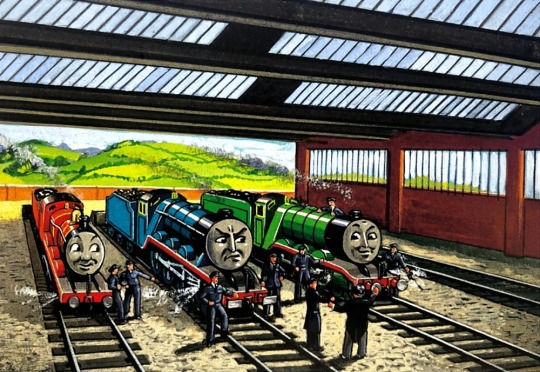
So we have these four core rules - but where did they come from? Well...
Regency Era Railways:
Straight off the bat - this is the era where every railway is figuring itself out. The L&MR was where everything was forged in fire - before it, the only railways that existed were isolated plateways in mines and the Stockton & Darlington Railway. None of these were anywhere near as complex as the L&MR, which is really the first railway 'system' in the way we might understand today. It's also where the first sentient engines begin to make a proper appearance and have an effect on people. Before, they were hidden in mines, if they existed at all - but now the public can see them!

Like, imagine this rocks up to collect you in an era when the most advanced method of transport is literally a horse. And it has a face. Remember, in this period people though that if they went over a certain speed or through a tunnel they would explode - so now the thing that might just kill them has a face?!
Managers would very quickly begin implementing ways to soothe their passengers. One way of doing that would be to dehumanise the engines - I can see many early engines being given basically no education because they are both seen as being 'working class' and because they are machines. When Rocket first ran, there were no public schools.
In this era, engines didn't know much, and they were isolated on their little systems. Yard managers are one of the few people with authority that these engines meet on a regular basis, and they use this to their advantage and cultivate this idea that the engines are entirely subservient to them. This is where that manager loyalty begins to become apparent - just not quite in its modern form.
The only education an engine would get is how to be loyal. Why should they learn signals, or passenger etiquette, or how to read? That is a driver or a guard's job. And so this really early era is characterised by dehumanisation and a lot of public-relations officers doing their best to downgrade the sentience of the engines. It's a lot of "yes they have a face, no they don't have intelligence, don't worry". This does extend into the Victorian era, as seen in Very Old Engines, as Skarloey arrives on Sodor with some principles taught at the workshop, only to be met with "you don't have rights, do your job." Which he naturally rebels at and then gets covered in a tarp for his troubles.
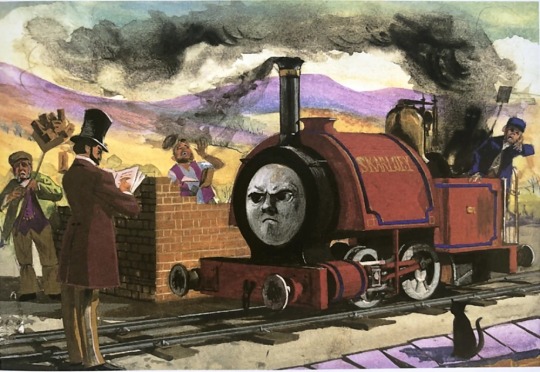
Of course, the Regency Era ends very soon into railway history, and just in time for a major game-changer.
The Victorian Era:
1838 is the year the first GWR train runs, and this railway in the South-west of England will have a huge impact on all railways that come after. First, the entire board of directors are very elitist and influential in parliament. This is a railway that needs to live up to its owners.
It is the GWR, not the L&MR, that writes the first book on engine learning. It's also the GWR, and not any other railway in the UK, that first develops a proper corporate culture for its engines that they actually like. The GWR does this by actually treating the engines like they have sentience.

Engines like Iron Duke are introduced to the 'Great Western Way' - this being the rulebook that Brunel and Gooch develop to best serve their wealthy owners. These engines are taught to read, understand the rules of the railway, passenger etiquette - which by now can be taught because there's less fumbling around blindly - and perhaps most importantly: they are taught a very proud mindset. The railway is the most important aspect of their lives, and they are to serve it to the best of their ability. All four of the rules appear in their first form here, except that the etiquette is not entirely based on duty, and instead all engines are taught all jobs - which horrified much of the rest of the railway companies.
But while this is going on on the GWR, the rest of the country's railways were trying to survive a crisis. Railway Mania swept Britain, and hundreds of engines and built (and destroyed) by the week. One thousand bills for new railways were submitted to parliament during this period, and while not all were built - it certainly had an impact. The LNWR was formed during this period, chunks of the Midland Railway, NER, GNR, GCR, Caledonian and basically every other major railway were all constructed in this time frame - but that didn't mean a drastic improvement in how the engines were treated in this area. Many North-western railways were influenced by the thinking from the L&MR, leading to entire fleets of early engines having zero clue how to act or even speak in some cases. When the bubble collapsed, many engines were scrapped - and this is where the other extremely important pillar stone of railway doctrine was introduced: engines are expendable, and should not want to hinder a company. The fourth rule is set into stone here, and goes unchanged and practically unchallenged all the way into the modern era.

This here, the end of steam in Britain, is able to happen because of principles introduced during Railway Mania. British Railways uses this rulebook and the laws that most likely surround it by this point to justify their actions, and also because thanks to this rulebook very few engines have the vague notion or idea to protest. Why would they, it goes against the rules!
The eradication of steam is almost directly caused by the era of Railway Mania and the principles managers introduced in the era to protect their profit margins. Without that doctrine, engines would have had a lot more rights and a lot more ability to protest being scrapped.
In other words, the 1840's was when scrapping began to appear properly, as well as the explosions, derailments and every other crash from the previous generation. Engines became unfeeling in this era - in the north at least. The GWR escaped this by being... well, not an economic bubble.
However, as the British Isles emerges from Railway Mania, two very strong railways vie for influence: the LNWR and the GWR. The LNWR has that traditional L&MR mindset - and it leads to a huge problem. The engines begin to learn how to speak from their crews, and moreover they question why their GWR counterparts are treated so much better. The LNWR also suffers from a number of easily preventable accidents caused by the engine having zero clue what to do.
Some railways land between the two, and it was the GNR that ended up formulating the four rules in their next evolution: engines were only taught their jobs. This was the GNR compromise with their board members. The board wanted a GWR approach, however the actual managers on the ground rebelled, worrying this would lead to the engines working together to demand fairer treatment. The Communist Manifesto was in major circulation at the time, and none of these companies wanted their engines getting any ideas. Instead, they implemented something of a class system, with express engines at the top and shunters at the bottom.
In the TVS, Emily is extremely abrasive towards Thomas (Seasons 8-12), and it may just have to do with the way she was raised, seeing shunters as the lowest form of engine. Gordon certainly did!

These three very distinct practices all melded and fused together on the Midland Railway - which of course ran right in between them all. The Midland Railway wrote the third proper rulebook in 1859, roughly twenty years after the GWR wrote its.
The Midland Railway's rulebook took the LNWR idea that engines needed to be taught to accept death, the GNR idea of a class system and the GWR importance of company loyalty and railway-rule-knowledge and fused them together, being able to create the rulebook that most British railways would use by 1890. The major exception to this was of course the Great Western, which slowly evolved its rulebook to use the LNWR ideas of engines being subservient to their managers while retaining the classless form of etiquette the engines were taught. The GNR would also hold out on some ideas from the GWR until it was amalgamated into the LNER, due to rising fears of Communism by the board.
Many smaller railways, such as the Furness Railway or the Highland Railway in Scotland, would use the GWR style, due to the smaller size of the workforce, and thus the potential necessity for engines to complete duties they were trained for.

Duck fits into his role at Tidmouth with such ease because he knows the theory behind every express train, every freight train, every style of shunting and branchline service. He doesn't need them, but the GWR engines were taught this just in case. Duck is excellent at his job, but he won't take any flak from the other engines because his GWR ideology makes him see them all as equal. This is of course part of the Great Western Way as explained in this post.
In direct contrast, Gordon has zero clue how to pull a freight train, and stalls on the hill because he physically doesn't know what to do.
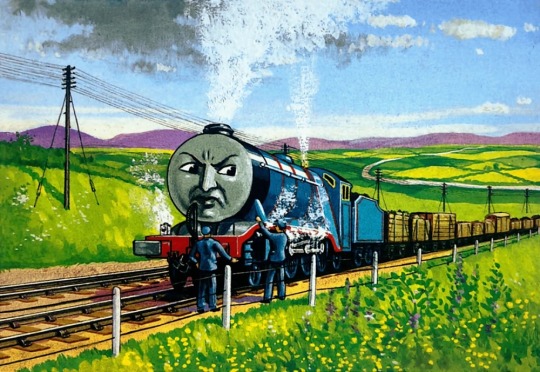
And this brings me quite neatly to Sir Topham Hatt I. See, this is a GWR man who runs a railway that is very heavily influenced by the Midland Railway rulebook ideology. Edward knows how to do multiple tasks because the Furness Railway used GWR practice (maybe that's why he likes Edward?) while none of the other engines do. Sir Topham Hatt's management style using GWR practice is so confusing to them. Why is James - who is mixed-traffic at best - pulling the express? Why is Gordon pulling freight? Why are the big engines shunting?!

And then we have Henry. Sir Topham and Henry have such a rocky relationship, and it in many ways comes from the fact that Henry had none of the formal education that I just discussed. He's a privately-built engine from stolen plans sold cheap. He doesn't actually know the etiquette of a passenger train - no wonder he stops when he doesn't like the weather! He doesn't physically know better, and so he's acting on his first instincts. This clashes so badly with the GWR style which places etiquette almost above everything else. Hatt reacts so badly and outright insanely to this because to him, Henry is actively and deliberately breaking every rule in the book because of his paint? And Henry doesn't have a clue. Look at how horrified he is!

And don't get me wrong, this is extremely unethical and very stupid, but it has a precedence in miscommunication, differing ideologies and Henry's foolishness.
This was another massive ramble with a lot of insanity, but I do enjoy writing these. Helps organise my mind! As usual, none of the above pictures belong to me, and feel free to chuck in a comment with your opinion!
#the 1800s#ttte edward#i need to calm down#thomas the tank engine#railway series#railways#real life railway#what are the rules for trains?#fanfiction writer#ao3 stuff#british rail#british railways#Great Northern Railway#gwr#Midland railway#LNWR#ttte au#sir topham hatt#ttte henry#ttte gordon#ttte skarloey#ttte duck#ttte emily#weirdo shit#long reads#very long post#britain#Great Western way
107 notes
·
View notes
Text

Our (very tiny) collection of law books guarded by Olive and Darlington. Most of them we picked based on various lists of "What you should read before starting Law school."
What other books would you recommend?
Tina
#law student#studyblr#law school#mature student#open university#university#lawblr#books#nonfiction#twins#studyspo#studying inspiration#study motivation#student life#study blog
7 notes
·
View notes
Text
High Wycombe teenager 13 Oliver Darlington died of sepsis after Christmas holiday to New York
High Wycombe teenager 13 Oliver Darlington died of sepsis after Christmas holiday to New York

[ad_1]
A fit and healthy schoolboy died of sepsis three days after he came down with cold-like symptoms during a Christmas family holiday to New York.
Oliver Darlington, 13, was running around Central Park on the final day of his family’s festive break to New York City, despite having a bit of a cold.
But after he flew back home to High Wycombe, Buckinghamshire, on December 30 he started to…
View On WordPress
0 notes
Text
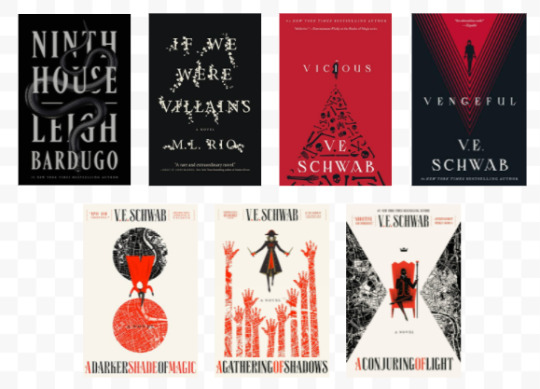
October Monthly Reading Wrap-Up
I read seven books this month. ✨
1. If We Were Villains, M.L. Rio — ★ 4.5/5 stars ★
2. Ninth House, Leigh Bardugo — ★ 3/5 stars ★
3. Vicious, V.E. Schwab — ★ 4/5 stars ★
4. Vengeful, V.E. Schwab — ★ 4.5/5 stars ★
5. A Darker Shade of Magic, V.E. Schwab — ★ 4.5/5 stars ★
6. A Gathering of Shadows, V.E. Schwab — ★ 4/5 stars ★
7. A Conjuring of Light, V.E. Schwab — ★ 5/5 stars ★
Keep reading for my unsolicited opinion on what I read this month.
1. If We Were Villains by M.L. Rio
If We Were Villains features a highly secretive group of friends: James Farrow, the hero, Alexander Vass, the villain, Richard Stirling, the tyrant, Meredith Dardenne, the femme fatale, Wren Stirling, the ingénue, Filippa Kosta, the chameleon, and Oliver Marks, the sidekick. It is set at Dellecher Classical Conservatory, a secluded Performing Arts College in Illinois, where they are the fourth (and final) year of students in the highly selective Shakespearean theater program led by Gwendolyn and Frederick. In the introduction, Oliver, the narrator, is released from prison after 10 years for a murder he may or may not have committed. Oliver narrates the sequence of events that led up to his imprisonment in an informal interview with former Chief of Police Joseph Colborne who led the investigation ten years prior. The characters are fully developed, as are their respective friendships, relationships, and group relationships. Their motivations are also fully developed; these motivations are reflected throughout the development of the story. As a result, If We Were Villains is a highly emotional mystery.
2. Ninth House by Leigh Bardugo
Ninth House follows Galaxy “Alex” Stern, the sole survivor of a multiple homicide. She is offered a scholarship to Yale University in New Haven, Connecticut where she becomes a member of the House of Lethe or the “Ninth House”. She serves as a “Dante” to “Virgil” Daniel “Darlington” Arlington. Together, they monitor the magical, paranormal, and supernatural activities of the Houses of the Veil, the eight elite, secret societies of Yale University. But soon, the Houses of the Veil start experimenting with forces beyond the Veil — and beyond their understanding.
Ninth House is well-written with multiple mysteries that feature magical, paranormal, and supernatural elements. However, I didn’t feel invested in Alex, Darlington, or any of the other characters. It was as if they lacked whatever it is that brings a character to life. The only character I felt invested in was Bertram Boyce North — and they were dead.
One of the difficulties I had with Ninth House was Alex’s character. I felt that Leigh Bardugo substituted their personality for their trauma. Trauma can shape someone’s personality, but it didn’t shape Alex’s personality; instead, it reduced it and even replaced it.
Another of the difficulties I had with Ninth House was its failure to deliver. Through Alex’s trauma, it dealt with themes of assault, abuse, and trauma as well as wealth, privilege, and power. It had the potential to deliver a powerful message on these themes, but I never felt like it truly delivered it. As a result, the graphic scenes of Alex’s trauma felt gratuitous, as if they were only there for shock value or as a substitute for Alex’s personality (or lack thereof).
I hope that the sequel further develops the characters that Ninth House introduced. I also hope that the sequel truly delivers the powerful message that Ninth House failed to.
3-4. Villains duology (Vicious and Vengeful) by V.E. Schwab
Vicious features former students and roommates at Lockland University, Victor Vale and Eliot “Eli” Cardale. Victor and Eli study the causes and effects of adrenaline, near death experiences, and superhuman abilities. Ten years later, Victor breaks out of prison. Together with Mitch Turner, a fellow inmate, and Sydney, a young girl with superhuman abilities, Victor is determined to exact their revenge on Eli. In the meantime, together with Serena, a young woman with superhuman abilities, Eli is determined to eradicate everyone with superhuman abilities — and Victor.
Both Vicious and Vengeful follow Victor and Eli. Vicious delves into Victor’s past while Vengeful delves into Eli’s past. Vengeful also follows Marcella Riggins, a woman who is determined to have revenge on her husband — and on the city of Merit. Together with June, a young woman with superhuman abilities, she sets out to become the most powerful woman — and the most powerful person — in the city of Merit.
In Vicious, men are the main characters and women are the side characters, but in Vengeful, women become the main characters. Vicious features rivalries between men while Vengeful features bonds between women. Vicious is a narrative of toxic masculinity while Vengeful in a narrative of feminism. I adored the themes of desire and determination, rage and revenge, and anger and ambition in Vengeful. To quote V.E. Schwab, “Vengeful is a 2018 reaction to a 2013 novel.”
#October Monthly Reading Wrap-Up#Monthly Reading Wrap-Up#Reading Wrap-Up#Wrap-Up#booklr#bookblr#bookish#book#books#bibliophile#your neighborhood bibliophile#your friendly neighborhood bibliophile#If We Were Villains#Ninth House#Vicious#Vengeful#A Darker Shade of Magic#A Gathering of Shadows#A Conjuring of Light
40 notes
·
View notes
Photo




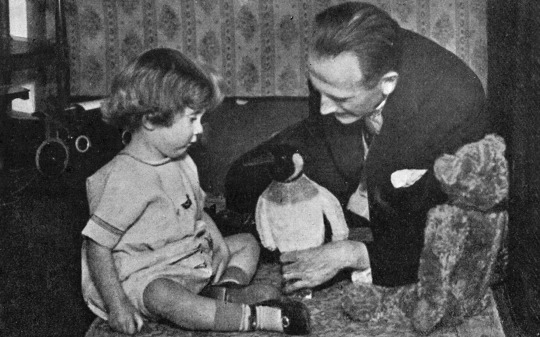
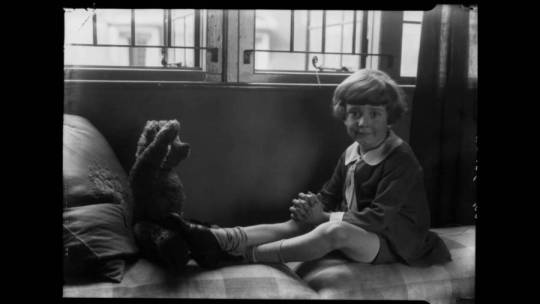
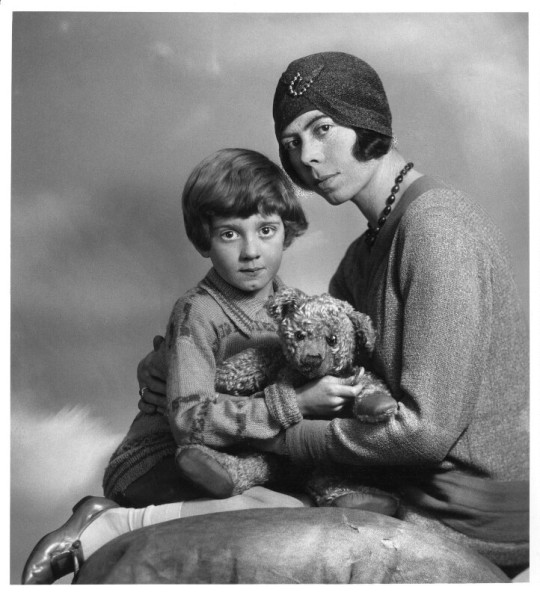



Arrivals & Departures
21 August 1920 – 20 April 1996
Christopher Robin Milne
Christopher Robin Milne was an English author and bookseller and the only child of author A. A. Milne. As a child, he was the basis of the character Christopher Robin in his father's Winnie-the-Pooh stories and in two books of poems.
Christopher Robin Milne was born at 11 Mallord Street, Chelsea, London, on 21 August 1920, to author Alan Alexander Milne and Daphne (née de Sélincourt) Milne. Milne speculated that he was an only child because "he had been a long time coming." From an early age, Milne was cared for by his nanny Olive Brockwell, until May 1930, when he entered boarding school. Milne called her Nou, and stated "Apart from her fortnight's holiday every September, we had not been out of each other's sight for more than a few hours at a time", and "we lived together in a large nursery on the top floor."
Milne's father explained that Rosemary was the intended name for their first born, if a girl. Realizing it was going to be a boy, he decided on Billy, but without the intention of actually christening him William. Instead, each parent chose a name, hence his legal name Christopher Robin. He was referred to within the family as Billy Moon, a combination of his nickname and his childhood mispronunciation of Milne. From 1929 onwards, he would be referred to simply as Christopher, and he later stated it was "The only name I feel to be really mine.
At his first birthday on 21 August 1921, Milne received an Alpha Farnell teddy bear, which he later named Edward. Eeyore was a Christmas present in 1921 and Piglet arrived undated. Edward, along with a real Canadian black bear named Winnipeg that Milne saw at London Zoo, eventually became the inspiration for the Winnie-the-Pooh character.
Milne spoke self-deprecatingly of his own intellect, "I may have been on the dim side", or "not very bright". He also described himself as being "good with his hands", and possessing a Meccano set. His self-descriptions included "girlish", since he had long hair and wore "girlish clothes", and being "very shy and 'un-self-possessed'".
An early childhood friend was Anne Darlington, also an only child, who as Milne described it, was for his parents "the Rosemary that I wasn't." Anne Darlington had a toy monkey, Jumbo, as dear to her as Pooh was to Christopher. Several poems by Milne, and several illustrations by E. H. Shepard, feature Anne and Christopher, notably "Buttercup Days", in which their relative hair colours (brown and golden blond) and their mutual affection is noted (the illustration to this latter poem, from Now We Are Six, also features the cottage at Cotchford Farm). To Alan and Daphne Milne, Anne was and remained to her death the Rosemary that Christopher wasn't, and Daphne long held fond hopes that Anne and Christopher would marry.
In 1925, Milne's father bought Cotchford Farm, near the Ashdown Forest in East Sussex. Though still living in London, the family would spend weekends, Easter, and summer holidays there. As Milne described it, "So there we were in 1925 with a cottage, a little bit of garden, a lot of jungle, two fields, a river, and then all the green, hilly countryside beyond, meadows and woods, waiting to be explored." The place became the inspiration for fiction, with Milne stating, "Gill's Lap that inspired Galleon's Lap, the group of pine trees on the other side of the main road that became the Six Pine Trees, the bridge over the river at Posingford that became Pooh-sticks Bridge," and a nearby "ancient walnut tree" became Pooh's House. His toys, Pooh, Eeyore, Piglet, plus two invented characters, Owl and Rabbit, came to life through Milne and his mother, to the point where his father could write stories about them. Kanga, Roo, and Tigger were later presents from his parents.
Of this time, Milne states, "I loved my Nanny, I loved Cotchford. I also quite liked being Christopher Robin and being famous."
When his nanny departed when he was age 9, Milne's relationship with his father grew. As he put it, "For nearly ten years I had clung to Nanny. For nearly ten more years I was to cling to him, adoring him as I had adored Nanny, so that he too became almost a part of me ..."
When Milne eventually wrote his memoirs, he dedicated them to Olive Brockwell, "Alice to millions, but Nou to me"
1 note
·
View note
Text

Veggie Olive Darlington
0 notes
Text
MP's who voted against free school meals: Part 1
Nigel Adams (Selby and Ainsty),
Bim Afolami (Hitchin and Harpenden),
Adam Afriyie (Windsor),
Imran Ahmad Khan (Wakefield),
Nickie Aiken (Cities of London and Westminster),
Peter Aldous (Waveney), Lucy Allan (Telford),
David Amess (Southend West), Lee Anderson (Ashfield),
Stuart Anderson (Wolverhampton South West),
Stuart Andrew (Pudsey),
Edward Argar (Charnwood),
Sarah Atherton (Wrexham),
Victoria Atkins (Louth and Horncastle),
Gareth Bacon (Orpington),
Richard Bacon (South Norfolk),
Kemi Badenoch (Saffron Walden),
Shaun Bailey (West Bromwich West),
Duncan Baker (North Norfolk),
Steve Baker (Wycombe),
Harriett Baldwin (West Worcestershire),
Steve Barclay (North East Cambridgeshire),
Simon Baynes (Clwyd South),
Aaron Bell (Newcastle-under-Lyme),
Scott Benton (Blackpool South),
Paul Beresford (Mole Valley),
Jake Berry (Rossendale and Darwen),
Saqib Bhatti (Meriden),
Bob Blackman (Harrow East),
Crispin Blunt (Reigate),
Peter Bone (Wellingborough),
Peter Bottomley (Worthing West),
Andrew Bowie (West Aberdeenshire and Kincardine),
Ben Bradley (Mansfield),
Karen Bradley (Staffordshire Moorlands),
Graham Brady (Altrincham and Sale West),
Suella Braverman (Fareham),
Jack Brereton (Stoke-on-Trent South),
Andrew Bridgen (North West Leicestershire),
Steve Brine (Winchester),
Paul Bristow (Peterborough),
Sara Britcliffe (Hyndburn),
James Brokenshire (Old Bexley and Sidcup),
Anthony Browne (South Cambridgeshire),
Fiona Bruce (Congleton),
Felicity Buchan (Kensington),
Robert Buckland (South Swindon),
Alex Burghart (Brentwood and Ongar),
Conor Burns (Bournemouth West),
Rob Butler (Aylesbury),
Alun Cairns (Vale of Glamorgan),
Andy Carter (Warrington South),
James Cartlidge (South Suffolk),
William Cash (Stone),
Miriam Cates (Penistone and Stocksbridge),
Maria Caulfield (Lewes), Alex Chalk (Cheltenham),
Rehman Chishti (Gillingham and Rainham),
Jo Churchill (Bury St Edmunds),
Greg Clark (Tunbridge Wells),
Simon Clarke (Middlesbrough South and East Cleveland),
Theo Clarke (Stafford),
Brendan Clarke-Smith (Bassetlaw),
Chris Clarkson (Heywood and Middleton),
James Cleverly (Braintree),
Therese Coffey (Suffolk Coastal),
Damian Collins (Folkestone and Hythe),
Alberto Costa (South Leicestershire),
Robert Courts (Witney),
Claire Coutinho (East Surrey),
Geoffrey Cox (Torridge and West Devon),
Virginia Crosbie (Ynys Mon),
James Daly (Bury North),
David T C Davies (Monmouth),
James Davies (Vale of Clwyd),
Gareth Davies (Grantham and Stamford),
Mims Davies (Mid Sussex),
Philip Davies (Shipley),
David Davis (Haltemprice and Howden),
Dehenna Davison (Bishop Auckland),
Caroline Dinenage (Gosport),
Sarah Dines (Derbyshire Dales),
Jonathan Djanogly (Huntingdon),
Michelle Donelan (Chippenham),
Nadine Dorries (Mid Bedfordshire),
Steve Double (St Austell and Newquay),
Oliver Dowden (Hertsmere),
Jackie Doyle-Price (Thurrock),
Richard Drax (South Dorset),
Flick Drummond (Meon Valley),
David Duguid (Banff and Buchan),
Iain Duncan Smith (Chingford and Woodford Green),
Philip Dunne (Ludlow),
Mark Eastwood (Dewsbury),
Ruth Edwards (Rushcliffe),
Michael Ellis (Northampton North),
Tobias Ellwood (Bournemouth East),
Natalie Elphicke (Dover),
George Eustice (Camborne and Redruth),
Luke Evans (Bosworth),
David Evennett (Bexleyheath and Crayford),
Ben Everitt (Milton Keynes North),
Michael Fabricant (Lichfield),
Laura Farris (Newbury),
Simon Fell (Barrow and Furness), Katherine Fletcher (South Ribble), Mark Fletcher (Bolsover), Nick Fletcher (Don Valley), Vicky Ford (Chelmsford), Kevin Foster (Torbay),
Mark Francois (Rayleigh and Wickford),
Lucy Frazer (South East Cambridgeshire),
George Freeman (Mid Norfolk),
Mike Freer (Finchley and Golders Green),
Richard Fuller (North East Bedfordshire),
Marcus Fysh (Yeovil),
Mark Garnier (Wyre Forest),
Nusrat Ghani (Wealden),
Nick Gibb (Bognor Regis and Littlehampton),
Peter Gibson (Darlington),
Jo Gideon (Stoke-on-Trent Central),
Cheryl Gillan (Chesham and Amersham),
John Glen (Salisbury),
Robert Goodwill (Scarborough and Whitby),
Michael Gove (Surrey Heath),
Richard Graham (Gloucester),
Helen Grant (Maidstone and The Weald),
James Gray (North Wiltshire),
Chris Grayling (Epsom and Ewell),
Chris Green (Bolton West),
Damian Green (Ashford),
Andrew Griffith (Arundel and South Downs),
Kate Griffiths (Burton),
James Grundy (Leigh),
Jonathan Gullis (Stoke-on-Trent North),
Luke Hall (Thornbury and Yate),
Stephen Hammond (Wimbledon),
Matt Hancock (West Suffolk),
Greg Hands (Chelsea and Fulham),
Mark Harper (Forest of Dean),
Rebecca Harris (Castle Point),
Trudy Harrison (Copeland),
Sally-Ann Hart (Hastings and Rye),
Simon Hart (Carmarthen West and South Pembrokeshire),
John Hayes (South Holland and The Deepings),
Oliver Heald (North East Hertfordshire),
Chris Heaton-Harris (Daventry),
Gordon Henderson (Sittingbourne and Sheppey),
Darren Henry (Broxtowe),
Antony Higginbotham (Burnley),
Damian Hinds (East Hampshire),
Kevin Hollinrake (Thirsk and Malton),
Philip Hollobone (Kettering),
Adam Holloway (Gravesham),
Paul Holmes (Eastleigh),
John Howell (Henley),
Paul Howell (Sedgefield),
Nigel Huddleston (Mid Worcestershire),
Eddie Hughes (Walsall North),
Jane Hunt (Loughborough),
Jeremy Hunt (South West Surrey),
Tom Hunt (Ipswich),
Alister Jack (Dumfries and Galloway),
Sajid Javid (Bromsgrove),
Ranil Jayawardena (North East Hampshire),
Mark Jenkinson (Workington),
Andrea Jenkyns (Morley and Outwood),
Robert Jenrick (Newark),
Boris Johnson (Uxbridge and South Ruislip),
Caroline Johnson (Sleaford and North Hykeham),
Gareth Johnson (Dartford), David Johnston (Wantage),
Andrew Jones (Harrogate and Knaresborough),
Fay Jones (Brecon and Radnorshire),
David Jones (Clwyd West),
Marcus Jones (Nuneaton),
Simon Jupp (East Devon),
Daniel Kawczynski (Shrewsbury and Atcham),
Alicia Kearns (Rutland and Melton),
Gillian Keegan (Chichester),
Julian Knight (Solihull),
Greg Knight (East Yorkshire),
Danny Kruger (Devizes),
Kwasi Kwarteng (Spelthorne),
John Lamont (Berwickshire, Roxburgh and Selkirk),
Robert Largan (High Peak),
Andrea Leadsom (South Northamptonshire),
Edward Leigh (Gainsborough),
Ian Levy (Blyth Valley),
Andrew Lewer (Northampton South),
Brandon Lewis (Great Yarmouth),
Ian Liddell-Grainger (Bridgwater and West Somerset),
Chris Loder (West Dorset),
Mark Logan (Bolton North East),
Marco Longhi (Dudley North),
Julia Lopez (Hornchurch and Upminster),
Jack Lopresti (Filton and Bradley Stoke),
Jonathan Lord (Woking),
Craig Mackinlay (South Thanet),
Cherilyn Mackrory (Truro and Falmouth),
Rachel Maclean (Redditch),
Alan Mak (Havant),
Kit Malthouse (North West Hampshire),
Anthony Mangnall (Totnes),
Scott Mann (North Cornwall),
Julie Marson (Hertford and Stortford),
Theresa May (Maidenhead),
Jerome Mayhew (Broadland),
Karl McCartney (Lincoln),
Mark Menzies (Fylde),
Johnny Mercer (Plymouth, Moor View),
Huw Merriman (Bexhill and Battle),
Stephen Metcalfe (South Basildon and East Thurrock),
Robin Millar (Aberconwy), Maria Miller (Basingstoke),
Amanda Milling (Cannock Chase),
Nigel Mills (Amber Valley),
Andrew Mitchell (Sutton Coldfield),
Gagan Mohindra (South West Hertfordshire),
Robbie Moore (Keighley),
Penny Mordaunt (Portsmouth North),
David Morris (Morecambe and Lunesdale),
James Morris (Halesowen and Rowley Regis),
Wendy Morton (Aldridge-Brownhills),
Kieran Mullan (Crewe and Nantwich),
David Mundell (Dumfriesshire, Clydesdale and Tweeddale),
Sheryll Murray (South East Cornwall),
Andrew Murrison (South West Wiltshire),
Robert Neill (Bromley and Chislehurst),
Caroline Nokes (Romsey and Southampton North),
Jesse Norman (Hereford and South Herefordshire),
Neil O'Brien (Harborough),
Guy Opperman (Hexham),
Owen Paterson (North Shropshire),
Mark Pawsey (Rugby),
Mike Penning (Hemel Hempstead),
John Penrose (Weston-super-Mare),
Chris Philp (Croydon South),
Christopher Pincher (Tamworth),
Rebecca Pow (Taunton Deane),
Victoria Prentis (Banbury),
Mark Pritchard (The Wrekin),
Jeremy Quin (Horsham),
Will Quince (Colchester),
Tom Randall (Gedling),
John Redwood (Wokingham),
Jacob Rees-Mogg (North East Somerset),
Nicola Richards (West Bromwich East),
Angela Richardson (Guildford),
Rob Roberts (Delyn),
Laurence Robertson (Tewkesbury),
Mary Robinson (Cheadle),
Andrew Rosindell (Romford),
Lee Rowley (North East Derbyshire),
Dean Russell (Watford),
David Rutley (Macclesfield),
Gary Sambrook (Birmingham, Northfield),
Selaine Saxby (North Devon), Paul Scully (Sutton and Cheam),
Bob Seely (Isle of Wight), Andrew Selous (South West Bedfordshire),
10 notes
·
View notes
Photo

1890

Anastasia Era Parthenia Wellesley
Anastasia came from old money and was the third child and daughter born to Sir Cornelius Abraham Eldridge Wellesley and Lady Augustine Clarice Victoria Darlington. She was her parents last attempt at having a son, sadly her mother died in childbirth. Childhood was uneventful for Anastasia, her sisters married off to wealthy men and her eldest sister, Josephine Docia Ernestine Wellesley’s husband was set to be her father’s heir.
At seventeen her father decided she was old enough to be married, Anastasia didn’t feel the same. She turned down all of the suitors her father found for her. Eventually Cornelius became fed up and chose a husband for her himself. Anastasia found herself engaged to a brutish man twice her age. Her second sister, Genevieve Mona Bernadette Wellesley, was married to a foul man like him and she didn’t want that. One evening she and her sisters visited the local market and as she was browsing she met a handsome that she’d never seen around before selling fruit from his farm. After approaching him under the guise of being interested in buying something, she learned his name was Douglas Ephraim Falkner and he lived on his large family farm on the outskirts of town. He seemed to like her as well and they exchanged information and the promise to write one another before Anastasia met back with her sisters. For months they exchanged letters in secret. When she could she’d sneak away and meet him, alone, away from the rest of town.
Her wedding was fast approaching and she knew she couldn’t marry the man her father had chosen. She was in love with Douglas. One night they made a plan, in the middle of the night Anastasia would take her wedding dress and a small number of her personal belongings and go to Douglas’ farm where they would marry in secret. Anastasia told only Genevieve, whom supported her decision. When the night came Anastasia with the help Genevieve made it to Douglas’ farm without a problem and they married on his farm.
Life after that was slow, Anastasia learned how to keep house and farm. Everyday the tended to the farm and on top of house chores is was back breaking work but Anastasia was happy with her choice. Eight months into the marriage Cornelius finally caught up to Anastasia. He came to take her back home but to his surprise and further humiliation she was heavily pregnant. He yelled at her but ultimately decided that he couldn’t bring her back home with him. That day she was officially disowned. Shortly after she gave birth to her and Douglas’ first children, twins, Dorothy Anna and Oliver John. Adding child rearing to her routine made the days even harder but she knew as soon as the children were old enough to help on the farm she could take a step back.
She and Douglas loved each other very much and showed one another as often as they could. This meant that shortly after having their first two babies Anastasia found herself pregnant again. This time she gave birth to triplets Winnifred Rose, Henrietta Opal and Howard Ellis. Unfortunately as it got colder tragedy struck, little Howard got sick and didn’t get better and sadly passed a several months after being born. However, Anastasia and Douglas just didn’t have much time in their busy lives to morn and Anastasia found herself pregnant once again. She gave birth to another baby boy little Emmett Lewis.
Dorothy and Oliver grew old enough to help their father on the farm and Anastasia got to step back from farm work to focus on child rearing and housework. She became a proficient cook and loved spending time with her small babies. Anastasia fell pregnant once again shortly after Henrietta and Winnifred celebrated their birthday. She gave birth early to a baby girl, Daisy Estelle. Because of her size Daisy didn’t survive long and she passed. Anastasia found time for herself to grieve but unfortunately her husband did not.
As Henrietta and Winnifred entered childhood they both became ill. Henrietta passed but Winnifred got better. Shortly after Douglas realized while they needed help on the farm they just did not have enough space for all the children. He convinced Anastasia it was time for their teenagers to move out to create their own families. Dorothy and Oliver were married off the neighboring farm families.
As Winnifred grew old enough to help on the farm and Emmett entered childhood, Anastasia found herself reflecting on her life thus far, missing the children she had lost but also immensely proud of the ones she still had. In the spring she found her self pregnant once again and that fall gave birth to triplets Eldora Emma, Virgil Sylvester and Violet Eunice.
Eventually Anastasia mastered cooking, she loved making meals and baking. The farm grew and began selling it’s own homemade nectar and jam. Anastasia was the one in charge of making the jams and nectars and she quickly mastered both crafts. Winnifred entered adulthood but wasn’t ready to marry and given her own experiences Anastasia didn’t want to force marriage upon her daughter. Douglas came up with a solution Winnifred could move out on her own if she allowed Emmett to come with her, so he could supervise her and keep her safe. Winnifred agreed to the terms and she and Emmett moved out to a small cottage down the road.
Eldora, Virgil and Violet grew old enough to help on the farm and Anastasia fell pregnant once again. She gave birth to twins Carlisle Charles and Florian Ambrose. The farm was thriving, their nectar business was booming and Anastasia couldn’t have been happier. She found that little Florian was clingier than her other children and she had to carrier him around as she did her chores. She became pregnant again, it was a tough pregnancy that ended up still-born. It was a boy, they named Percy Warren and he was buried in at the Falkner Family burial site.
In her teenage hood Eldora met and fell in love with a neighbor boy and Anastasia and Douglas allowed her to marry him. After Eldora moved out Anastasia found out she was was pregnant again. It was another turbulent pregnancy that resulted in a baby girl, Imogene Drucilla. After little Imogene was born Anastasia and Douglas decided to stop having children. While none of their other children were necessarily planned they couldn’t handle potentially losing another child.
Carlisle and Florian grew older but Florian didn’t grow out of his clingy-ness. He was a full on mama’s boy. Anastasia wouldn’t say it out loud but she secretly loved it. She told him stories from her childhood and about the shenanigans she and her sisters would get into. She and Douglas also noticed that Violet seemed peculiar. She was always odd as a child but as she entered teenage-hood they noticed she became more strange, she had mood-swings and spoke to herself. They weren’t sure what to do about it so they did nothing.
One day Anastasia found herself feeling ill, as months went by it got worse. She couldn’t keep food down, was lethargic, and lost an immense amount of weight. They paid for doctor’s to come and look at her but they could never pin point what was wrong. Eventually her mystery illness took her in her sleep. She left behind her husband Douglas and children Dorothy, Oliver, Winnifred, Emmett, Eldora, Virgil, Violet, Carlisle, Florian, and Imogene. She was buried next to her children in the burial site on the farm.
1 note
·
View note
Text
My Model Locomotive Collection 2019
AKA; Locomotives Currently Stationed At Taddlecombe Junction Shed For Use On Both Main and Branch Line Services

LNER A4 No. 4468 Mallard
Built: 3 March 1938, Doncaster Works
Designer: Sir Herbert Nigel Gresley
Withdrawn: 25 April 1963
Fate: Preserved in the National Collection at York
Condition of Model: As built (1938)

BR Peppercorn A1 No. 60163 Tornado
Built: 1 August 2008, Darlington Works
Designer: Arthur Peppercorn/A1 Locomotive Trust
Withdrawn: N/A
Fate: Operational on main line
Condition of Model: As built (2008)
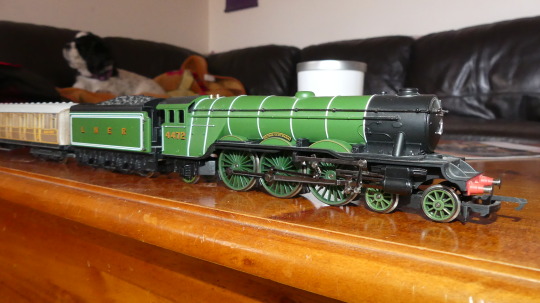
LNER Gresley A1 No. 4472 Flying Scotsman
Built: February 1923, Doncaster Works
Designer: Sir Herbert Nigel Gresley
Withdrawn: 15 January 1963
Fate: Preserved in the National Collection at York
Condition of Model: c. 1928 condition
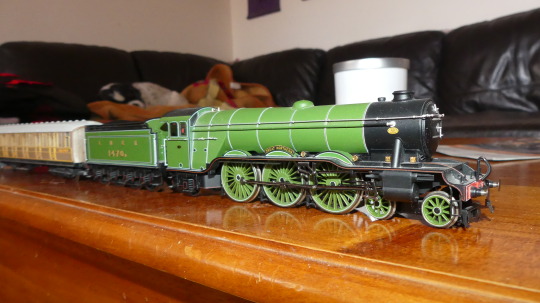
LNER A1 No. 4470 Great Northern
Built: April 1922, Doncaster Works (by the Great Northern Railway)
Designer: Sir Herbert Nigel Gresley
Withdrawn: Rebuilt 1945 as Thompson A1/1, withdrawn November 1962
Fate: Scrapped
Condition of Model: 1923 livery.
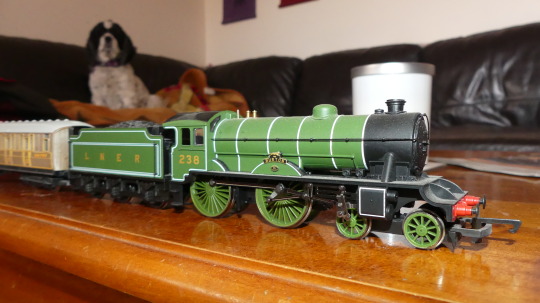
LNER D49/2 ‘Hunt’ No. 238 The Burton
Built: August 1934, Darlington Works
Designer: Sir Herbert Nigel Gresley
Withdrawn: December 1957
Fate: Scrapped
Condition of Model: As built (1934)
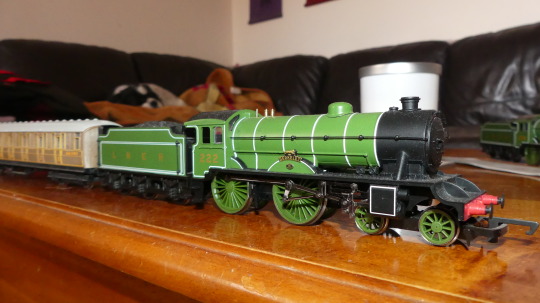
LNER D49/2 ‘Hunt’ No. 222 The Berkeley
Built: July 1934, Darlington Works
Designer: Sir Herbert Nigel Gresley
Withdrawn: November 1959
Fate: Scrapped
Condition of Model: As built (1934)
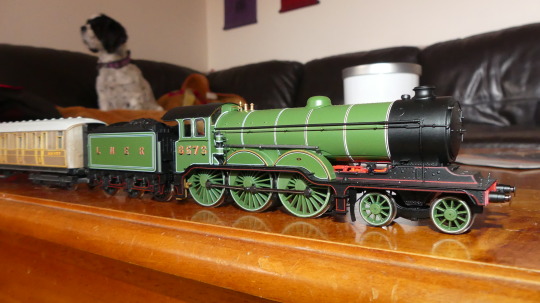
LNER B12/3 No. 8573
Built: August 1928, Beyer Peacock & Co.
Designer: S.D Holden/Sir Herbert Nigel Gresley
Withdrawn: January 1959
Fate: Scrapped
Condition of Model: As built (1928)

LNER P2 No. 2001 Cock O’ The North
Built: May 1934, Doncaster Works
Designer: Sir Herbert Nigel Gresley
Withdrawn: Rebuilt 1944 as Thompson A2/2, withdrawn February 1960
Fate: Scrapped
Condition of Model: As built (1934)

British Railways 7P ‘Britannia’ No. 70036 Boadica
Built: December 1952, Crewe Works
Designer: R. A. Riddles
Withdrawn: October 1966
Fate: Scrapped
Condition of Model: As built (1952)

British Railways 9F No. 92220 Evening Star
Built: March 1960, Swindon Works
Designer: R. A. Riddles
Withdrawn: March 1965
Fate: Preserved in the National Collection at York
Condition of Model: As present

British Railways A4 No. 60033 Seagull
Built: June 1938, Doncaster Works (by the LNER)
Designer: Sir Herbert Nigel Gresley
Withdrawn: December 1962
Fate: Scrapped
Condition of Model: Late 1950s/Early 1960s
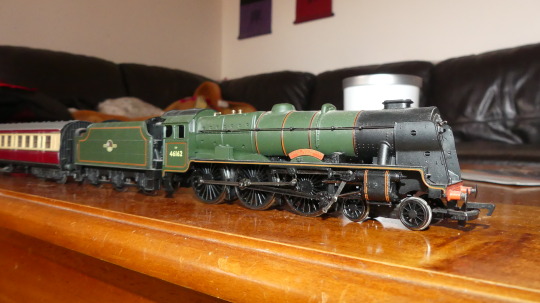
British Railways Rebuilt Royal Scot No. 46162 Queen’s Westminster Rifleman
Built: September 1930, Derby Works (by the LMS)
Designer: Sir Henry Fowler/Sir William Stanier
Withdrawn: May 1964
Fate: Scrapped
Condition of Model: Late 1950s/Early 1960s

British Railways D49/2 No. 62760 The Cotswold
Built: September 1934, Darlington Works (for the LNER)
Designer: Sir Herbert Nigel Gresley
Withdrawn: October 1959
Fate: Scrapped
Condition of Model: Early 1950s
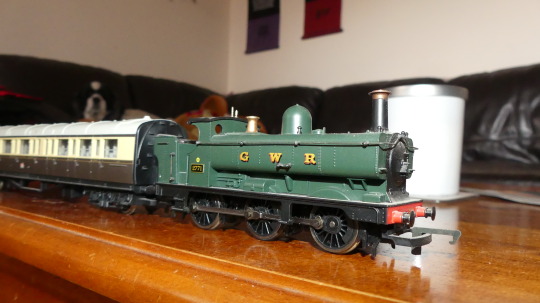
Great Western Railway 2721-class No. 2771
Built: September 1900, Swindon Works
Designer: William Dean
Withdrawn: June 1950
Fate: Scrapped
Condition of Model: 1920s/30s
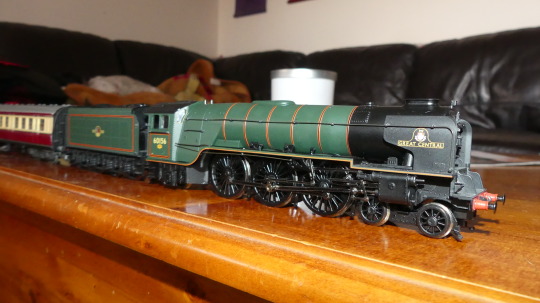
British Railways Peppercorn A1 No. 60156 Great Central
Built: October 1949, Doncaster Works
Designer: Arthur Peppercorn
Withdrawn: May 1965
Fate: Scrapped
Condition of Model: Late 1950s/Early 1960s
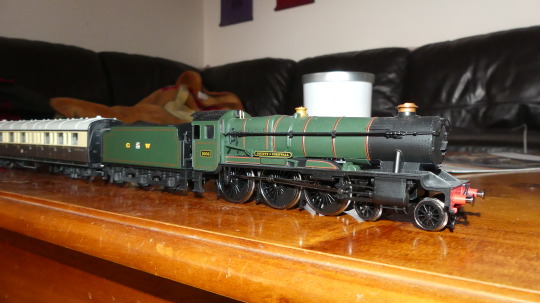
Great Western Railway County-class No. 1006 County of Cornwall
Built: November 1945, Swindon Works
Designer: Frederick Hawksworth
Withdrawn: September 1963
Fate: Scrapped
Condition of Model: As built (1945)

North Western Railway Modified A1 No. 4 Gordon
Built: 1922, Doncaster Works
Designer: Sir Herbert Nigel Gresley/Sir Topham Hatt
Withdrawn: N/A
Fate: In service
Condition of Model: As present

North Western Railway Modified Class 28 James
Built: c. 1912, Horwich Works
Designer: George Hughes/Sir Topham Hatt
Withdrawn: N/A
Fate: In service
Condition of Model: As present
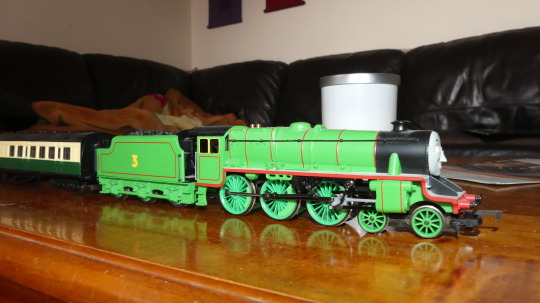
North Western Railway 5MT No. 3 Henry
Built: 1922, Derby Works
Designer: Sir William Stanier
Withdrawn: N/A (rebuilt as 5MT in 1935 at Crewe Works)
Fate: In service
Condition of Model: As present
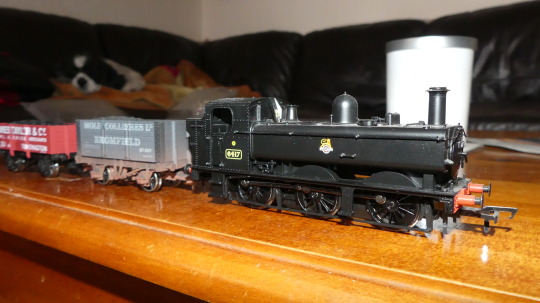
British Railways 6400-class No. 6417
Built: December 1934, Swindon Works (for the GWR)
Designer: Charles Collett
Withdrawn: June 1959
Fate: Scrapped
Condition of Model: Early 1950s

Southern Railway Q1 No. C21
Built: June 1942, Ashford Works
Designer: Oliver Bulleid
Withdrawn: August 1963
Fate: Scrapped
Condition of Model: As built (1942)

Peak Rail Austerity Lord Phil
Built: 1943, Hunslet (for the War Department)
Designer: R. A. Riddles
Withdrawn: 1980s?
Fate: Preserved by Peak Rail
Condition of Model: As present

LNER J94 (Austerity) No. 8009
Built: March 1944, Hunslet (for the War Department)
Designer: R. A. Riddles
Withdrawn: July 1962
Fate: Scrapped
Condition of Model: c. 1946

Totally Fictitious Hornby Railroad 0-4-0
Built: It wasn’t
Designer: Hornby
Withdrawn: N/A
Fate: N/A
Condition of Model: pretty
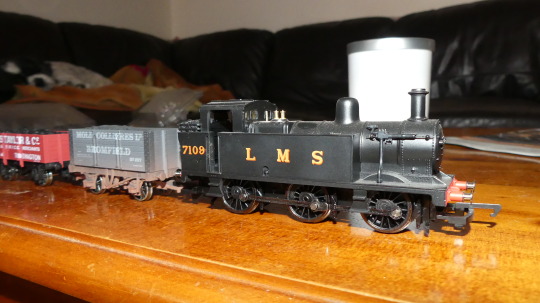
LMS 3F Jinty No. 7109
Built: July 1924, Vulcan Foundry
Designer: Sir Henry Fowler
Withdrawn: September 1962
Fate: Scrapped
Condition of Model: As built (1924)
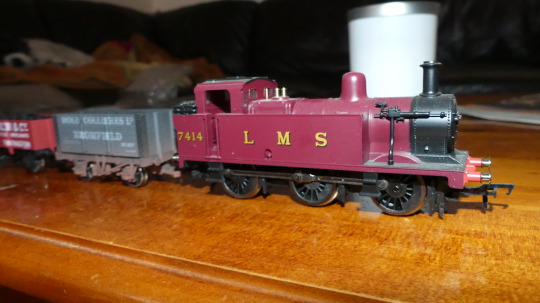
LMS 3F Jinty No. 7414
Built: December 1926, Vulcan Foundry
Designer: Sir Henry Fowler
Withdrawn: May 1962
Fate: Scrapped
Condition of Model: 1930s (livery fictional?)
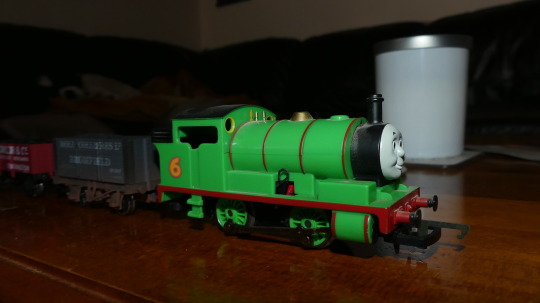
North Western Railway Avonside No. 6 Percy
Built: c. 1950, Avonside Works
Designer: Avonside
Withdrawn: N/A
Fate: In service
Condition of Model: As present
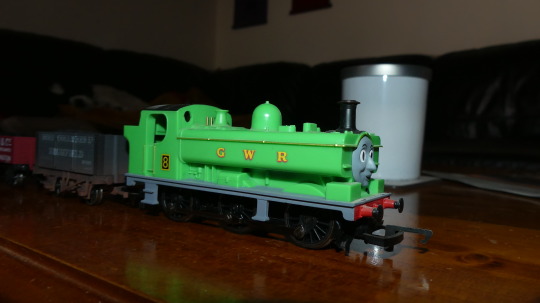
North Western Railway 5700-class No. 8 Montague (’Duck’)
Built: c. 1930, Swindon Works
Designer: Charles Collett
Withdrawn: N/A
Fate: In service
Condition of Model: As present

Sodor China Clay Works No. 2 Ben
Built: 1953, W. G Bagnall
Designer: W. G. Bagnall
Withdrawn: N/A
Fate: In service
Condition of Model: As present

North Western Railway J70 No. 7 Toby
Built: 1903, Stratford Works
Designer: James Holden
Withdrawn: N/A
Fate: In service
Condition of Model: As present
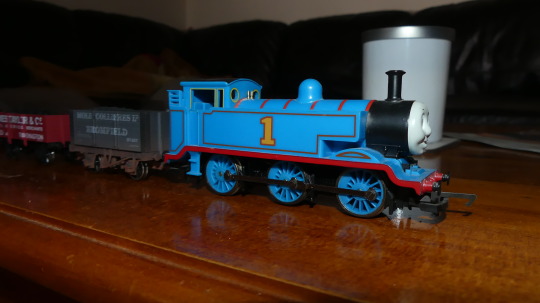
North Western Railway Modified E2 No. 1 Thomas
Built: c. 1916, Brighton Works
Designer: Lawson Billington/Sir Topham Hatt
Withdrawn: N/A
Fate: In service
Condition of Model: As present

LMS Caledonian Single No. 14010
Built: 1886, Neilson & Co.
Designer: Dugald Drummond
Withdrawn: 1935
Fate: Displayed in the Riverside Museum in Glasgow
Condition of Model: As in 1935
30 notes
·
View notes
Text


Olive
Basset Hound x Labrador Retriever |F| Darlington, SC
#basset hound#labrador retriever#mixed breed#rescue dog#shelter dog#adoptdontshop#cute animals#petfinder
13 notes
·
View notes
Photo

REVIEW
The Wicked Wallflower by Tracy Sumner
The Duchess Society #5
Slipping back into this series was smooth and easy and oh so much fun!
What I liked:
* Lady Philippa Darlington: free spirit, looking for her place in life, sister of a duke, friend, difficult backstory, wants to give back, crush on Xander Macauley, assists the Duchess Society and is assisted by them, too.
* Xander Macauley: wealthy, owner of many businesses, illegitimate son of an Earl, grew up on the streets, good friend, assists the underdog, gives back to the community, rake, hedonist, trying to desperately to avoid Philippa…though there is definitely a spark between them.
* Watching the relationship between Philippa and Xander develop
* Seeing how well Xander and Philippa really know one another
* Realizing how well suited the two are for one another
* How well the couple communicated
* Catching up with the couples in previous books of the series
* Being introduced to the characters that will be in the next two books…looking forward to both books (Dash, Theodosia, Oliver, and “the gardener”
* Reading about Cassiopeia in this book and realizing that the book just read also referred to that heavenly body and the mythology surrounding it – both books were historical romances – made me wonder if the universe sends out hints to authors that are picked up by more than one at the same time
* The writing, plot, pacing, people, and all the rest
* All of it really except…
What I didn’t like:
* Thinking about how tough it was and had been for more than one character in this book
* Having to wait for the next book in the series
Did I like this book? Yes
Would I read more in this series? Definitely!
NOTE: Stayed up till 1:30aam reading in spite of an electricity cut knowing I had to get up early in the morning…couldn’t put it down!
Thank you to the author and WOLF Publishing for the ARC – this is my honest review.
5 Stars
BLURB
A slow-burn battle of wills leads to love.
Their biggest secret? Their infatuation with each other.
Independent, impulsive Lady Philippa Darlington guarantees her freedom by playing the role of a wallflower. After two miserable seasons in the ton, she’s vowed to never marry with the help of the most dreaded female enterprise in London—the Duchess Society. But a madcap misadventure will throw her plans off course and put her face-to-face with the most dangerous man she’s ever known.
Common-born Xander Macauley crawled from the slums to rule an empire. And he has secrets. One being that he’s smitten with his best friend’s little sister. Although Pippa Darlington is the last woman in England he’d risk his heart over. However, after a snowstorm forces them together and she lets him see the enchanting woman beneath the bluster, Xander finds he will do everything in his power to possess her.
The risks are undeniable. But so is the chance to find a true, overwhelming love.
#Tracy Sumner#The Duchess Society 5#WOLF Publishing#Historical Romance#Romance#Fiction#Historical Fiction#Steamy Romance#friends to lovers
0 notes